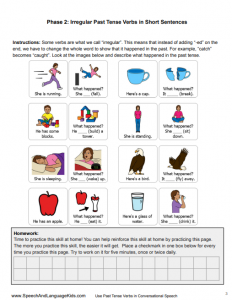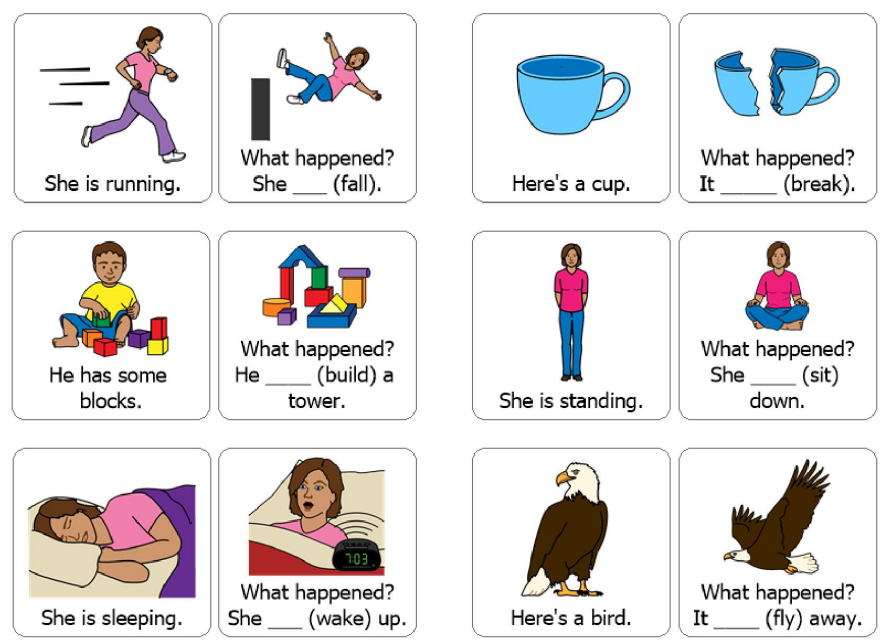How to Teach Past Tense | Activities and Ideas for Teaching Kids
How do we teach regular and irregular past tense verbs to children?
What can I do to help a child who is struggling to use past tense verbs correctly?
On this page, we’ll give you a step-by-step process for teaching children to use past tense verbs correctly. Plus, we’ll show you how to access our Grammar Curriculum that contains pre-made activities and resources for teaching past tense verbs and other grammatical structures.
Why do some children struggle with past tense verbs?
Many children with language delays have difficulty using the past tense of verbs. If they want to talk about something that already happened, they will use the present tense or may mis-form the word to create regular/simple past tense or irregular past tense. This can make it difficult to tell when a child is talking about something in the past or something they want to do right now. Here are the steps for how to teach past tense verbs to a child in speech therapy, in the classroom, or at home.
How can I teach a child to use past tense verbs correctly?
We can use speech therapy activities and exercises to systematically teach a child to use past tense verbs correctly. Watch the video below and follow the steps to past tense verb success! (Or, take the short cut and grab our pre-made verb curriculums here)
1. Choose Regular (Past Simple) or Irregular Past Tense Verbs to Target
Just as when we are teaching other grammatical markers, we need to focus on one thing at a time. The first thing you must do is decide whether or not you need to teach regular past tense verbs (past simple) or irregular past tense verbs first. You really do need to pick one at a time as it can be confusing to target them all at once. Start with regular past tense verbs and once the child has a good handle on those, then you can move to the irregular ones.
2. Find Before & After Pictures to Teach Past Tense
The easiest way to teach past tense verbs is to have a collection of pictures that include before and after pictures of the same scene. These will give you a prompt for asking the question “what happened”. The examples below are from our Grammar/Syntax Curriculum. But you can also look around and see what you already have.
3. Teach Past Tense about Immediate Past
Once you have chosen present/past tense and you have collected your pictures, it’s time to teach past tense verbs using actions that have just happened (as opposed to something that happened a while ago). Show the child one of your before pictures and describe what happened. Then, show the child the second picture and say “what happened?” The child should be able to describe the action that was performed, even if he doesn’t know how to use the past tense yet. If not, you may want to go back and work on labeling actions before you work on the past tense of them. Model the correct past tense use of the word the child just provided and tell him that since it’s something that already happened, you have to change the word. Here’s how that might sound during the activity:
- Look, she is running! (Show second picture) Oh no! What happened?
- Child: Fall down!
- You’re right, she fell. Listen, that’s something that already happened, so we’re going to change it. Instead of “fall”, we’re going to say “fell”. Listen, she fell.
- Child: She fell.
Keep doing this activity until the child can appropriately use the past tense to talk about the actions that are represented.
4. Teach Past Tense to Retell Past Events
Once the child understands the basics of how to change a verb to create the past tense, it’s time to use the past tense to retell past events. These would be events that happened more than a few minutes ago. Ask the child to talk about past events like recess, birthday parties, going on a trip, or event from his day. While he’s doing this, make sure he’s using the past tense. If he forgets, you can use the same cues as you did in step three by telling him that it’s something that already happened so we have to change the word. Keep doing this until the child can recall past events using the correct past tense verbs.
5. Teach Past Tense Verbs in Conversational Speech
Now that the child is able to use past tense when describing pictures and when recalling past events, the only thing left is everyday conversation. Whenever you hear the child incorrectly use the past tense in conversation, help remind her in the same way you did in the other steps. Eventually, she’ll be able to do this on her own and not need reminders from you anymore.
A Structured Program for Teaching Grammar/Syntax Skills:
Improving grammar and syntax skills takes more than a one-off activity.
That’s why we’ve created a full curriculum to teach grammar and syntax skills, including past tense verbs!
Grab a subscription to our SLK Curriculum and get access to the Grammar/Syntax Curriculum along with all of our other courses, resources, and AI-Powered Material Generators.

About the Author: Carrie Clark, MA CCC-SLP
Hi, I’m Carrie! I’m a speech-language pathologist from Columbia, Missouri, USA. I’ve worked with children and teenagers of all ages in schools, preschools, and even my own private practice. I love digging through the research on speech and language topics and breaking it down into step-by-step plans for my followers.
Fun Fact: My favorite success story from a client was a little 4-year-old who said his name correctly for the first time ever. His speech problems made it so no one could ever understand him when they asked him what his name was. We had been working for weeks on saying the individual syllables separately and then trying to put them together. The joy on his face when he finally said it correctly was worth every minute we spent on it! 😍
Connect with Me:





Hi Carrie,
I came across you post on teaching past tense verbs and I really like the approach that you suggest. I am interested in purchasing your “before and after” picture deck, however when I click on the link that you provide I get an error page. Is this deck still available? Thanks.
It probably got blocked by your school/work network. I just sent it to you in an email. Let me know if you don’t get it!
Comment…please I need the pictures too. fybamigboye@gmail.com
Please email me at Carrie@Speechandlanguagekids.com
Hi Carrie,
I am also interested in your “before and after” picture deck, but the link says the site is no longer available. Can you email me too? Thank you!
Ok, I sent them. Check your spam if you don’t see it.
Hi Carrie,
Great idea! I am not able to access the website either. Can you please send me or direct me to where I can find them? Thank you for your help!
Hi! What is it exactly that you’re having trouble accessing?
Hi! The link you posted for the before and after deck is not working.
Whoops! Right you are! That was an old link, that deck is now a free download. Here’s the link: https://www.speechandlanguagekids.com/past-tense-verbs-flash-cards/
Hey there , i want to be a teacher and i really find the method useful . Unfortunatly i can not get the pictures , if it possible email them for me . Thank you
Nasrinkazemi738@gmail.com
Hi, Nasrin-
Please try this link to access the materials.
hey i am interested can you please send me the pictures via email. snnekomba92@gmail.com
Hi, Junior-
Not sure if you are still in need of these past tense cards, but here is the link, just in case.
Thanks. Please I need the pictures.
Hi, Abigail-I have emailed you the requested materials. Please let us know if you have any further questions.